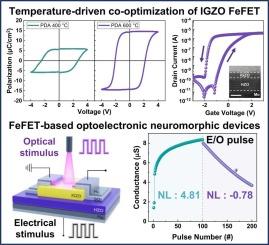Temperature-driven co-optimization of IGZO/HZO ferroelectric field-effect transistors for optoelectronic neuromorphic computing
IF 17.1
1区 材料科学
Q1 CHEMISTRY, PHYSICAL
引用次数: 0
Abstract
The integration of ferroelectricity and the photoelectric effect offers substantial potential for the realization of optoelectronic-based artificial neural networks (ANNs) and biomimetic systems. Despite their potential, the application of ferroelectric field-effect transistors (FeFETs) in optoelectronic neuromorphic devices, where light regulates synaptic activation, remains largely unexplored. Here, we report InGaZnO/Zr-doped HfO2 (IGZO/HZO) artificial synapses for the emulation of optoelectronic ANNs and optogenetic-inspired neural functions. Particularly, by simultaneously optimizing the post-deposition annealing (PDA) process for the stabilization of HZO ferroelectric phase and activation of IGZO channel, high-performance FeFETs exhibiting a memory window of ∼1 V and endurance up to 104 cycles were achieved. Spectroscopic analyses correlated PDA temperature-dependent dynamic transitions in electrical properties with hydrogen relocation, oxygen vacancy formation, zinc vaporization, and film densification. The IGZO/HZO synapses successfully emulated synaptic functions such as spike-amplitude and spike-duration-dependent plasticity, using both electrical (E) and optical (O) stimulation. Furthermore, dual E/O stimulus activation of IGZO/HZO synapses, combined with polarization state modulation, was employed to emulate optogenetic-inspired neural functions. We also demonstrated that dual E/O stimulus activation of artificial synapses enhanced ANN image recognition accuracy from 86 % to 90 %, outperforming the performance achieved with a single E-stimulation. We envision that these findings can provide a process protocol for IGZO/HZO FeFETs to achieve stable phasic control and realization of optoelectronic neuromorphic devices.

用于光电神经形态计算的 IGZO/HZO 铁电场效应晶体管的温度驱动协同优化
铁电性与光电效应的结合为实现基于光电的人工神经网络和仿生系统提供了巨大的潜力。尽管具有潜力,铁电场效应晶体管(fefet)在光电神经形态器件中的应用(光调节突触激活)在很大程度上仍未被探索。在这里,我们报道了InGaZnO/ zr掺杂的HfO2 (IGZO/HZO)人工突触,用于模拟光电人工神经网络和光遗传启发的神经功能。特别是,通过同时优化沉积后退火(PDA)工艺来稳定HZO铁电相和激活IGZO通道,实现了具有~1 V记忆窗口和长达104次循环的高性能fet。光谱分析将PDA温度相关的电性能动态转变与氢重定位、氧空位形成、锌蒸发和薄膜致密化联系起来。IGZO/HZO突触利用电(E)和光(O)刺激成功地模拟了突触功能,如峰值振幅和峰值持续时间依赖的可塑性。此外,IGZO/HZO突触的双E/O刺激激活,结合极化状态调制,被用来模拟光遗传启发的神经功能。我们还证明,人工突触的双E/O刺激激活将人工神经网络图像识别的准确率从86%提高到90%,优于单E刺激的性能。我们设想这些发现可以为IGZO/HZO效应场效应管提供一个过程协议,以实现稳定的相位控制和光电神经形态器件的实现。
本文章由计算机程序翻译,如有差异,请以英文原文为准。
求助全文
约1分钟内获得全文
求助全文
来源期刊

Nano Energy
CHEMISTRY, PHYSICAL-NANOSCIENCE & NANOTECHNOLOGY
CiteScore
30.30
自引率
7.40%
发文量
1207
审稿时长
23 days
期刊介绍:
Nano Energy is a multidisciplinary, rapid-publication forum of original peer-reviewed contributions on the science and engineering of nanomaterials and nanodevices used in all forms of energy harvesting, conversion, storage, utilization and policy. Through its mixture of articles, reviews, communications, research news, and information on key developments, Nano Energy provides a comprehensive coverage of this exciting and dynamic field which joins nanoscience and nanotechnology with energy science. The journal is relevant to all those who are interested in nanomaterials solutions to the energy problem.
Nano Energy publishes original experimental and theoretical research on all aspects of energy-related research which utilizes nanomaterials and nanotechnology. Manuscripts of four types are considered: review articles which inform readers of the latest research and advances in energy science; rapid communications which feature exciting research breakthroughs in the field; full-length articles which report comprehensive research developments; and news and opinions which comment on topical issues or express views on the developments in related fields.
 求助内容:
求助内容: 应助结果提醒方式:
应助结果提醒方式:


